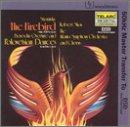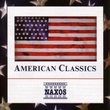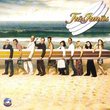| All Artists: Alexander Borodin, Igor Stravinsky, Robert Shaw, Atlanta Symphony Orchestra Title: Stravinsky: The Firebird Suite; Borodin: Music from Prince Igor Members Wishing: 2 Total Copies: 0 Label: Telarc Release Date: 2/28/2001 Album Type: Hybrid SACD - DSD Genre: Classical Styles: Opera & Classical Vocal, Historical Periods, Modern, 20th, & 21st Century, Symphonies Number of Discs: 1 SwapaCD Credits: 1 UPC: 089408003905 |
Search - Alexander Borodin, Igor Stravinsky, Robert Shaw :: Stravinsky: The Firebird Suite; Borodin: Music from Prince Igor
 | Alexander Borodin, Igor Stravinsky, Robert Shaw Stravinsky: The Firebird Suite; Borodin: Music from Prince Igor Genre: Classical
|
Larger Image |
CD DetailsSimilar CDs |
CD ReviewsHigh Art Meets High Fidelity in This Stunning Hybrid SACD! James Yelvington | USA | 01/20/2010 (5 out of 5 stars) "
In June of 1978, when the world of recorded music was essentially analog (despite growing public awareness of the digital realm through increased accessibility of simple home computers) there was a kind of "summit" meeting between high art and high technology in Atlanta's Symphony Hall. Art was represented by conductor Robert Shaw and the Atlanta Symphony Orchestra and Chorus; technology by Telarc recording engineer Jack Renner and the Soundstream digital recording apparatus. The result of this happy encounter was a superb digital recording in stereo of Stravinsky's Firebird ballet suite (1919) and excerpts from Borodin's opera Prince Igor, the artists and technicians apparently outdoing themselves on the pioneering project. From this recording, standard (analog) vinyl LP disks were manufactured for the great bulk of recorded music listeners, for there was then no widely accessible means of purveying digital music to the general public. About five years later, after Sony and Philips had introduced compact disk technology, the recording was re-released on CD, thus affording the benefits of digital recording to those willing to buy a CD player. The CD was warmly welcomed, for it provided wider frequency response and dynamic range (volume), much less distortion, and freedom from noise due to disk flaws and wear. The transition to CD did involve certain difficulties and compromises, however: the original 50 kHz sampling rate had to be converted to CD's standard 44.1 kHz--a process not without some error. Later, when Sony and Philips introduced their Super Audio Compact Disk (SACD) format with its underlying Direct-Stream Digital (DSD) recording mode, it became possible to produce a significantly improved digital recording, and in 2000 Telarc released the present Hybrid SACD version of the recording. By converting the old Soundstream recordings to the greatly superior DSD system it had become possible to make new CDs and SACDs without the resampling artifacts of the earlier CD release, and by employing Hybrid SACD technology both CD and SACD versions could be incorporated in the same disk. Thus it is that the full fidelity of the old 1978 recording is finally available on the SACD layer of the present disk. But for those who (like me) do not own a SACD player, the disk can be played on a standard CD player and yield very nearly all the original fidelity, only missing the arguably inaudible 22kHz-25kHz frequency band. (20kHz has long been considered a practical upper limit for human hearing.) But enough of mind-numbing technological palaver. Leaving behind this morass of detail (well documented in the liner notes), along with additional hotly argued acoustic subtleties so far unmentioned, let us focus on what we like best--listening to good music. Strictly speaking, the following remarks apply only to the CD layer of this disk, though I doubt the SACD layer differs to any great degree. The performances here are outstanding. Though I have heard the Firebird countless times, here it seems fresher, clearer, more natural, more sonically sensuous, and more coherent musically than ever before. It is delightful! (Though Stravinsky was reluctant to write this music he rose impressively to the occasion and thereby brought himself more international acclaim than he could ever have imagined. It reminds me of Tchaikovsky's reluctance to write the Nutcracker music, which proved to be one of his greatest--and most loved--compositional triumphs.) The Prince Igor overture and Polovtsian dances are less spectacular, of course, but sonically and musically very fine nonetheless. (Borodin considered himself a chemist/professor and only a dabbler in music composition. He even lost or never wrote down the overture to Prince Igor, which was reconstructed by Glazounov from hearing him perform it at the piano. Ultimately, history and his musical colleagues have corrected Borodin's modest self-perception and assigned to him an important place in 19th century music.) The inclusion of chorus on the dances adds to the delight of these tuneful and exotic pieces. It is a no-brainer to assign this Hybrid SACD the highest rating available. Though there are numerous other recordings of these pieces, some of them very fine, I don't believe any quite come up to the level of musical artistry and sonic excellence found here. And fortunately you can enjoy all, or nearly all, this bounty without plunking down for a SACD player: just pop it into your CD player, lean back, and soak up the good vibes! " |

 Track Listings (8) - Disc #1
Track Listings (8) - Disc #1


